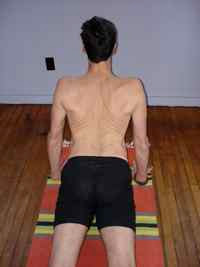This and that

Frequently students will ask me, should I do the technique this way, or that way? Quite often, the answer is yes. One of the gifts of a regular hatha yoga practice is helping us to grasp the rather elusive concepts of nondual philosophy. Rather than seeing truth, love and compassion as something to be attained, yoga demonstrates that our divinity is within. Our practice helps us shift this recognition from latency to potency.
While these ideas are described by many texts in philosophical terms, it’s rare to explore these ideas in working with the body. Rather than the postures being this or that, can we expand our understanding to see that the postures are this and that? As we work with the body, can we recognize moment by moment our inherent goodness?
As mentioned in previous blog entries, the yoga that’s risen to prominence in the West often imposes the poses on the body. Our mind carries a set of instructions for the proper execution of the pose, and imposes these ideas on the body. Within this paradigm is the tacit assumption that intelligence resides in the mind, and the body is a lump of ignorance. Were this true, you’d have to concentrate very hard after every meal to direct your digestive processes. Getting a papercut would involve a week or more off work, as you’d have to concentrate very hard to mobilize the intelligence to coagulate the blood, form a scab, and knit the tissues together. Clearly there’s an intelligence present besides our capacity to think, and yoga practice can help reveal this intelligence.
The shoulder girdle is a particular apt place to explore these seemingly esoteric ideas. I can’t tell you how often I hear the instruction to pull the shoulder blades down and back. While this may be a good instruction for the beginning student, all bets are off when working with more experienced students. I often find experienced students taking this instruction to such an extreme, that they’re actually increasing their stiffness and congestion in the process. I’ve worked with hundreds of experienced yoga students still living with chronic neck pain, TMJ, headaches and other symptoms of imbalance caused by the over-use of this once-useful cue.
The body is a system, and opening one area by congesting another area is a zero net gain. When working with the body, robbing Peter to pay Paul is a dead-end road. It’s said that pulling the shoulders down and back opens the heart. If the heart-center only existed in the chest, this would be OK. We find, however, that the heart-center exists in three-dimensions. It has a back (between the shoulder blades) just as certainly as it has a front (in the chest). To open the heart involves creating space in both the front and the back… simultaneously.
In Urdvha Mukha Svanasana (Upward Facing Dog Pose) there’s an opportunity to open the heart if we can we open the chest and open the back at the same time. Performed in this way, Upward Dog isn’t a chest opener any more than it’s a back opener – it’s simultaneously both – the true heart-opening pose. It’s this and that, or put more classically, it’s neither this nor that.
Stay tuned for next week’s video instruction on Upward Facing Dog Pose.



Comments